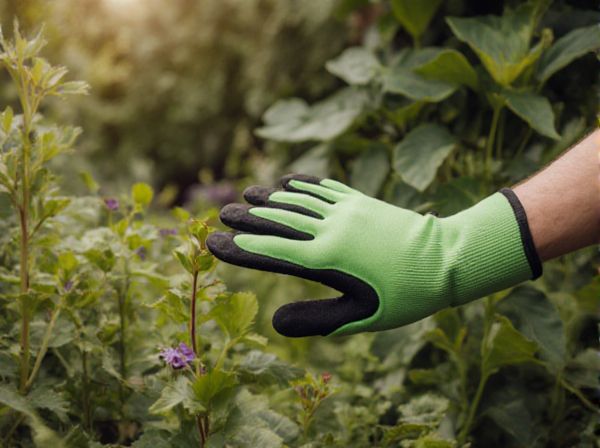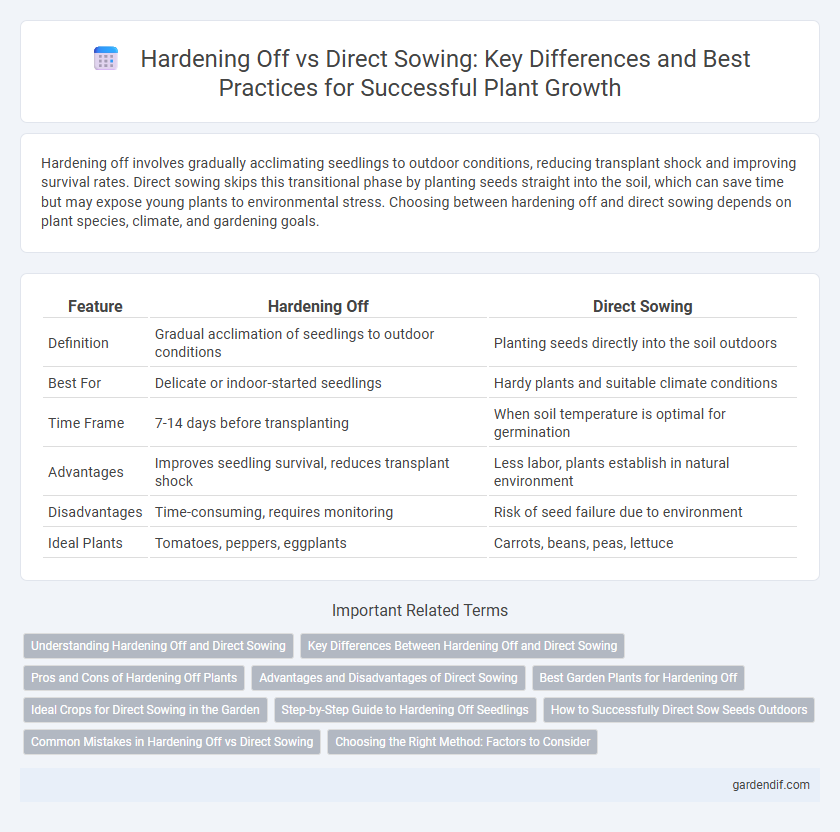
Hardening off vs Direct sowing Illustration
Hardening off involves gradually acclimating seedlings to outdoor conditions, reducing transplant shock and improving survival rates. Direct sowing skips this transitional phase by planting seeds straight into the soil, which can save time but may expose young plants to environmental stress. Choosing between hardening off and direct sowing depends on plant species, climate, and gardening goals.
Table of Comparison
| Feature | Hardening Off | Direct Sowing |
|---|---|---|
| Definition | Gradual acclimation of seedlings to outdoor conditions | Planting seeds directly into the soil outdoors |
| Best For | Delicate or indoor-started seedlings | Hardy plants and suitable climate conditions |
| Time Frame | 7-14 days before transplanting | When soil temperature is optimal for germination |
| Advantages | Improves seedling survival, reduces transplant shock | Less labor, plants establish in natural environment |
| Disadvantages | Time-consuming, requires monitoring | Risk of seed failure due to environment |
| Ideal Plants | Tomatoes, peppers, eggplants | Carrots, beans, peas, lettuce |
Understanding Hardening Off and Direct Sowing
Hardening off is the gradual acclimatization of seedlings to outdoor conditions, enhancing their survival and growth when transplanted. Direct sowing involves planting seeds directly into the soil, bypassing indoor stages, which can save time and reduce transplant shock but may expose seeds to environmental risks. Both methods impact plant establishment, with hardening off suited for sensitive seedlings and direct sowing advantageous in stable growing climates.
Key Differences Between Hardening Off and Direct Sowing
Hardening off involves gradually exposing seedlings to outdoor conditions to acclimate them before transplanting, reducing shock and increasing survival rates. Direct sowing skips the indoor stage, planting seeds directly into the soil where natural conditions dictate germination and growth, often preferred for hardier plants and larger garden spaces. Key differences include control over initial growth environments, timing flexibility, and plant stress tolerance, influencing overall plant development and yield.
Pros and Cons of Hardening Off Plants
Hardening off plants involves gradually acclimating seedlings to outdoor conditions, reducing transplant shock and increasing survival rates, which leads to stronger, more resilient growth. This process requires time and careful monitoring to avoid stress from sudden temperature or light changes, making it less convenient than direct sowing. However, hardening off can significantly improve plant establishment and yield compared to direct sowing, especially in variable climates or short growing seasons.
Advantages and Disadvantages of Direct Sowing
Direct sowing offers advantages such as reduced transplant shock and the ability to establish plants in their natural environment from the start, leading to stronger root systems. It requires less labor and equipment compared to hardening off seedlings, making it cost-effective for large-scale planting. However, direct sowing also carries risks like variable germination rates and increased vulnerability to pests, weather fluctuations, and soil conditions, potentially resulting in uneven plant development.
Best Garden Plants for Hardening Off
Hardening off refers to the gradual acclimatization of indoor-grown seedlings to outdoor conditions, improving their survival rates when transplanted. Best garden plants for hardening off include tomatoes, peppers, and eggplants, which benefit from controlled exposure to sunlight, wind, and temperature fluctuations before planting. Direct sowing is suitable for root vegetables like carrots and radishes, which prefer to grow uninterrupted in the soil without transplant shock.
Ideal Crops for Direct Sowing in the Garden
Ideal crops for direct sowing in the garden include root vegetables like carrots and radishes, leafy greens such as spinach and lettuce, and legumes like peas and beans. These plants tolerate soil disturbances and establish quickly without the need for transplanting, minimizing stress and promoting stronger root systems. Direct sowing also suits heat-loving crops like cucumbers and squash that thrive when planted directly into warm soil conditions.
Step-by-Step Guide to Hardening Off Seedlings
Hardening off seedlings involves gradually exposing young plants to outdoor conditions over 7-10 days to build resilience against wind, sunlight, and temperature fluctuations. Begin by placing seedlings outdoors in a shaded, protected area for a few hours each day, slowly increasing exposure time and sunlight intensity. This step-by-step process reduces transplant shock and improves overall survival rates compared to direct sowing, which bypasses this acclimatization period.
How to Successfully Direct Sow Seeds Outdoors
Direct sowing seeds outdoors involves planting them directly into the garden soil at the appropriate time for the specific plant species, ensuring optimal temperature and moisture conditions for germination. Selecting quality seeds, preparing loose, well-drained soil free of weeds, and maintaining consistent moisture without waterlogging are crucial for successful seed establishment. Monitoring soil temperature to match the seed's requirements and thinning seedlings after germination promotes healthy growth and reduces competition.
Common Mistakes in Hardening Off vs Direct Sowing
Common mistakes in hardening off include exposing seedlings to harsh sunlight or cold temperatures too quickly, leading to plant shock and stunted growth. Direct sowing errors often involve planting seeds at incorrect depths or during unfavorable weather conditions, resulting in poor germination rates. Both methods require careful attention to timing and environmental factors to ensure healthy plant development.
Choosing the Right Method: Factors to Consider
Choosing between hardening off and direct sowing depends on the plant species, climate conditions, and growing season length. Hardening off is essential for seedlings grown indoors, gradually acclimating them to outdoor environments to enhance survival rates. Direct sowing is preferable for hardy plants that establish well in soil without transplantation, reducing labor and transplant shock risks.
Hardening off vs Direct sowing Infographic

 gardendif.com
gardendif.com